Vortext Optics
https://www.vortexoptics.com/
High end optics have historically not done well in the American market, We will spend any number of hard earned dollars for the newest and greatest rifle in the newest and most devastating caliber, but when we go to buy a scope for it, we cheap out. Europeans tend to go the opposite way. They will take much more pride in a fine optic than a fine rifle, and that is where they prefer to spend their money. An American will put a $500 scope on a $3,000 rifle, whereas a European will put a $3,000 optic on a $1,000 rifle.
I don’t know when this changed, but it is recent. All of a sudden, right here in the good old USA, optics in the $1,500 plus range have come into focus in the market (pun intended), and people are buying them.
I tend to be of the traditional mindset and have never spent more than $500 for a scope. But when Vortex recently sent me their Razor HD for a review, I got it. I understand now why a quality optic should be a lifetime purchase decision now, and I regret the years that I have beaten myself over the head trying to get a standard deer rifle scope to do the work of a precision optic.
This is the ULTIMATE OPTIC SMACKDOWN. You will never look at your scope the same way again. And if you own a precision rifle and you haven’t spent the money on a precision optic yet, this article is going to give you the basics of what you are probably missing. My intention is not to compare one expensive scope to another. Head to head there are intangibles brand to brand that are tough to compare. This article is about the Vortex Razor HD, and how it differs from the scope that is probably on your rifle now.
Image Quality
You know how you can never get your pictures that you take with your snappy camera to come out as well as the pictures in the magazines? You might think that the reason is that you don’t know as much as professional photographers. That is only a small part of the story. The majority of the difference between the pictures you see in magazines and the ones you take with your snappy camera is in the lens of the camera. Your pixels may be in the tens of millions but your lens is inferior.
A high quality camera lens is much like a high end rifleoptic. The glass lenses inside the whole apparatus we call a “lens” are extremely high quality and precise.. They are specially layered and coated, perfectly matched and perfectly aligned. Don’t forget that you don’t see things. What you “see” is the light traveling back from the thing to your eye. When this light passes through several lenses to bring the image closer, the clarity, alignment and precision of those lenses are paramount to you seeing a clear picture. High end optics give you that clear picture.
Lesser optics may claim superior alignment and clarity, but go to a gun shop with a good optics selection and check for yourself. Lay an expensive scope on a rest and look through it for a couple of minutes, then compare it to an inexpensive one. You can even to two from the same manufacturer. You will immediately notice the difference in clarity in the center, and especially the edges. Then see how tired your eye gets while looking through the inexpensive one after a minute or so. The expensive one will give you much less eye fatigue, because your eye isn’t fighting to compensate for the internal lenses in the scope that aren’t aligned as perfectly as they are in an expensive scope. That push and pull that your eye is forced to endure on an inexpensive scope costs you when it is time to make the shot. It is a very tangible reason alone to invest in an optic that will help you shoot your best.
Besides eye relief, the benefit of optimum lens alignment and uniformity is a brighter, clearer picture of what you are aiming at downrange. It also allows you to use more of your reticle when “holding over” for distance or wind, because the entire field of view is in focus and clear instead of just the middle. If you don’t have the time to use turret adjustments to make your shot, it could be that you are forced to hang on the edge of the reticle. With the Razor HD this is not only possible, the reticle is made to do it. Vortex has provided windage and elevation marks to the very outside edge at full magnification, and the drop and wind compensation is within the bounds of hundreds of yards for most sniper and hunting cartridges.
Of all the reasons to buy a high end optic, this is the most important. A once in lifetime shot only comes once in a lifetime, and in battlefield conditions it may be your life that is actually on the line. A big, bright, clear picture with a fully usable field of view is what a high end optic is all about, and what makes it worth the money. Some of the features below you can actually find on some optics in the $500 – $700 range (Vortex makes one themselves), but the optical quality of a high end scope will always be unmatched by a cheaper scope. You get what you pay for with optics.
First Focal Plane Reticle
There is a ton of internet chatter regarding what is called a “first focal plane” reticle. I have found it to be terribly confusing and often misleading, but I finally figured it out. Inside the scope is what is called the reticle, which is the crosshairs or lines you see when you look through. It is engraved or printed on one of the pieces of glass. The difference in placing the reticle on the first piece of glass or the second piece of glass makes a difference in how the how the reticle behaves when you zoom the scope. There is no difference in reticles in a fixed focal length scope.
In a first focal plane reticle the size of the crosshairs zooms with the image as you zoom the scope. So at lowest power, 5x on the Razor, the crosshairs are very fine. Drop and windage are a very small part of the field of view when the scope is zoomed to the lowest power so Vortex even zooms in a three point battle sight around the normal crosshairs. At high magnification the crosshairs zoom out larger and fill the entire field of view. The result is that the area covered by the black + mark of the crosshairs themselves on the target is always the same.
In a second focal plane reticle, which is most likely what you have on your deer rifle scope, the size of the crosshairs never change. The target zooms with the power adjustment of the scope, so the amount of the target that the + in the crosshairs covers varies as the target zooms bigger and smaller. This has significant disadvantages.
- Precision shot placement – In both battle and hunting situations there will always be times when you don’t have time enough to zoom your scope. Sometimes you have to just take the shot. Keeping your scope at high magnification is not generally desirable because if you encounter something close, the scope will be useless, leaving you to point your weapon at the target with nothing but a blurry picture with a few inch field of view. Dialing the scope out to low magnification is standard practice. If you then need to take a quick shot with the time to dial your scope out to higher magnification, the X formed by the crosshairs of a second focal plane scope may be too thick for a precise shot at more than 100 yards. A first focal plane scope will give you the focus and field of view for close targets as well as the fine crosshairs for a precision shot at long distance.
- Easy distance calculations – Zooming the reticle with the image means that the distances between the lines, and the thickness of the lines, always stay relative to the target. This gives you the ability to estimate range using these lines no matter what magnification power the scope is dialed into. On a second focal plane scope you must first adjust the scope to a given power before being able to use it to estimate range, or use an extra range calculation in your equation. Range estimation is beyond the scope of this article for now, but it will be included in a future edition of GunsAmerica Magazine.
- Easy bullet drop calculations – Bullet drop can be figured out in inches at a given distance or in minutes of angle (MOA) or milliradians (Mils or Mrads). When the reticle zooms with the image, the relative MOA/Mils/MRAds will stay the same, so if your drop is 4.3 Mrads at 640 meters, the hold over or turret click adjustment will be the same no matter what magnification the scope is dialed into. In a second focal plane scope you are again, forced to either zoom the scope to a given magnification or do an extra calculation.
After substantial research both offline and online I have not found a valid argument for the superiority of a second focal plane reticle in the modern age. Past criticisms of first focal plane reticles involved the sharpness of the reticle at different distances, the ability to hold zero, and some bozo even suggested that you didn’t need to be able to use your scope to estimate distance because if you can afford an expensive scope you can afford a laser rangefinder. The quality issues certainly don’t apply to the Razor HD. At all distances the reticle is sharp and focused, and we have tested it extensively for holding zero at different distances with great results. Ben Becker, our resident Army Sniper, used the Razor HD to shoot 1” groups at 500 yards with a $300 Savage rifle in a previous article, and he dialed in the 500 yard shots after zeroing at 100 yards. The first round was on the button. And as for using the scope for ranging, I’ll gamble on a little knowledge and excellent scope before the Energizer bunny any day. If something can go wrong it will and batteries always fall out or die when you need them the most.
Adjustable Zero Stop Knobs
You are of course familiar with the standard adjustment knobs and caps on a regular scope. Once the rifle is “zeroed” there is no room for adjustment in the field and the caps are screwed on to protect the adjustment. The thinking with this is that most hunting cartridges are fairly “flat” in their trajectory and you don’t need to adjust the scope at normal hunting distances. I’m not sure how sound this is, but it is what it is and it is the way it is done. If the scope reticle has marks in it for measuring holdovers and windage, you can make do.
Many scopes in the $300-$700 range have adjustable knobs attached to their turrets so that after you zero the scope you can “dial in” a new distance using the clicks in the knobs, and hit your target first shot from just the scope adjustments, with no holdover or windage compensation done through the reticle while aiming. If you have time for this to make the shot, actually adjustments would be preferred by most shooters. As long as the clicks are true to what they are supposed to be, which is no guarantee in that price range (you know who you are), this is enough for the first shot, or first target.
But after the shot, when you want to return the scope to its zero point, that is where many of the lesser scopes get into trouble. Referencing the scope back to that zero point can be quite difficult. Some scopes have a way to hold the knob so that it can be easily brought back to zero, and I can’t say that I have tried many of them. But the ones I have tried don’t work well and are confusing.
The Vortex scope has what they call their RZR Stop Set. There are actually two adjustable turrets, one that slides on top of the other. So when you zero the scope, you remove the top turret, zero, then lock the inside turret so that it can’t be dialed down further than the zero point. You do the same thing with the windage turret. Then you carefully slide the outside turret down over the inside turret so that the Zero (0) point is exactly over the set line. Dialing the scope out for a shot is counted with clicks, in either ¼ MOA or 1/10th MIL/MRad (your choice when you buy the scope), and returning to zero is just a matter of turning the turret until it stops. There is also a backup system on the post of the knobs themselves that show elevation lines. So you know that your zero is above line number two, at turret Zero (0). It works great.
Parallax Adjustment
Parallax is a lot easier to adjust than it is to understand. As I mentioned before, we don’t see things. We see the light that returns to our eye from the things we see. This light, on a magnifying optic, is focused on a focal plane, and into our eye. Parallax problems arise because we are seeing the distant object on the same focal plane as the reticle, but of course the reticle is inside the scope and the thing is way out there somewhere. At varying distances there is an adjustment that can be made inside the scope, and the more expensive scopes will have this feature as standard. Using a parallax adjustment is easy. You look through the reticle and your distant thing and move your head back and forth. Find the approximate distance you are shooting at on the parallax knob, then turn it slightly until the image and reticle don’t move when your head moves. When it is properly adjusted, you will not need to make sure your eye is in perfectly alignment with the axis of the scope and the distant thing to sight it correctly. If there is no parallax adjustment on your scope, you will have parallax errors in your sighting if you are not perfectly straight.
Overall Fit and Finish, and Attention to Detail
Call me picky, but if I pay $2,000 or more for an optic, I want it to feel like I paid that much for it. I want absolute attention to detail and I want all of the bugs worked out of a design before I buy it. This is after all, the ULTIMATE OPTICS SMACKDOWN, so I’d like to address the stuff we are smacking down. I have had all kind of quirks with my $300-$500 optics over the years and I have to say, Vortex has addressed every single one with this Razor HD. For one, it tells you in big white letters which way is right and which way is up on the knobs. It tells you on the actual knob and post how many clicks you have done, even several turns around, without having to count them. Every click is exactly as advertised (mine is a 1/10th Mil/MRad). The knobs have a fiber optic and recessed zero reference. It comes with high quality flip up scope caps. It comes with a hood. It comes with a battery for the illumination. You can buy the battery in Wal-Mart even on re-stocking day. It comes with a reflection screen for sniper work. It comes with a bubble level you can use or not use. The finish is very well done and the rubberized ring for zooming holds on when you turn it. And the directions are clear and helpful, and written just for this model of scope.
Illumination
Quite a few low priced tactical scopes have adequate illumination. An illuminated reticle makes it so even a faintly outlined target can be sighted, without the need for night vision or target illumination. Since most of us are punching paper and dinging steel, and the range closes at dark, I wouldn’t call it a deal killer one way or the other. But there are differences with illumination in the expensive scope models. The Vortex Razor HD has eleven levels of illumination to match varying levels of brightness conditions. You only want as much illumination as is required to see the reticle. More will make the lines of the reticle too “thick” for precision shots, and close your eye retina, hampering your natural night vision. On the Razor there is an off click between every level, so you can find the right level, turn off the battery, and you are one click away from returning to that level. You don’t have to click through the levels to get to the one you want. The other thing I like about the illumination on the Razor is that it lights up the entire reticle, including the windage marks, so ranging and holdoffs are all illuminated.
Mils, Mrads, and MOA
I think part of the consumer demand for these high end scopes has come from many of the hundreds of thousands of American veterans coming home from the Iraq and Afghanistan who have had exposure to high end optics in the service. The military doesn’t use reticles that are set up to measure minutes of angle, or MOA. The miltary works with what is called the Mil-dot system, which is short for milliradian. Vortex calls them Mrads, and though they make the Razor HD in both an MOA and Mrad model, those of you used to the militar Mil-dot system will for sure want the Mrads, which is the model I use.
An MOA scope generally provides one click for each ¼ minute of angle. A minute of angle is 1/60th of a degree, A circle has 360 degrees in it (think of a compass). That angle-span coming out from the center of the circle in 1/60th of 1/360th is 1/21,600th of the circle. One of those, coincidentally and conveniently equals 1.047 inches at 100 yards exactly. So if you are sighting in your rifle at 100 yards, we generally think of one click as equal to ¼ of an inch.
To estimate distance using an MOA marked reticle, you figure out the inches in height of something at the distance of your target, multiply it times 100 and divide it by how many minutes of angle that thing measured in your (ideally first focal plane) reticle, you get yards. So if you estimate the receiver of an AK-47 at 4 inches, and it measured one MOA according to the marks in your reticle, your target would be 400 yards away. A high end reticle like the EBR-1 of the Razor MOA model will even give you fractions of a minute, so you can estimate your distance extremely accurately.
The Mil-dot or Mrad system is harder to explain. It is based on radians, which are equidistant slices of a circle that none of us need to deeply understand. A milliradian is 1/1000th of a radian and it is bigger than a minute of angle. One mil equals 3.438 minutes of angle, or 3.6 inches at 100 yards. The clicks on the Razor HD are 1/10 of a mil/Mrad, so each click is .36 inches instead of approximately .25 inches with the MOA model.
The important difference between Mil-dots/Mrads and MOA is that the Mil-dot/Mrad system is that the equations for distance using the reticle can be done in even numbers yards to yards and meters to meters, whichever you think or have been trained in. The equation is target size in yards or meters, times 1000, divided by Mils/Mrads, equals yards or meters. So if you estimate the height of a man at two yards and he measured 2 Mils/Mrads in your reticle, he is 1000 yards away.
What you choose is more a matter of preference and experience than superiority. When it comes to the other use of your reticle, calculating bullet drop and windage adjustment, most people find Mils/Mrads easier to use. The important thing is to learn your bullet drop in MOA or Mils/Mrads, not inches. That way you have the visual representation of the number right in your reticle, which can give you instant sighting and instant target engagement.
Once you experience the features you found here in our ULTIMATE OPTIC SMACKDOWN, I don’t believe you will ever have a quiet heart taking a run of the mill (pun intended) deer rifle scope into the field, even on your deer rifle. A scope like the Vortex Razor HD gives you a sense of power and purpose, and I believe it is worth every penny.
Vortext Optics
https://www.vortexoptics.com/


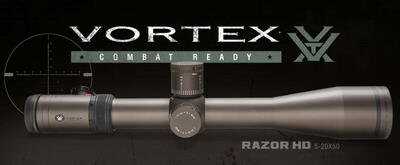
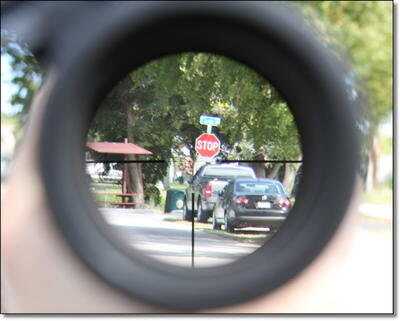
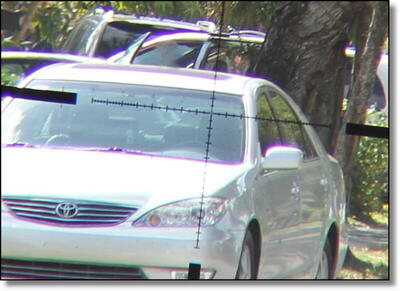
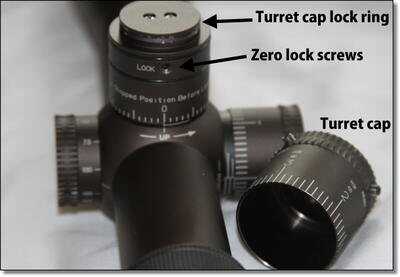
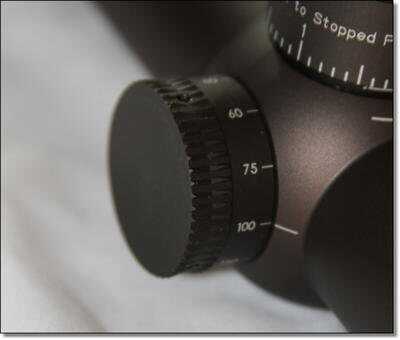
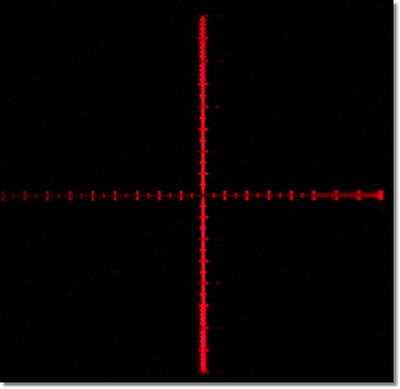
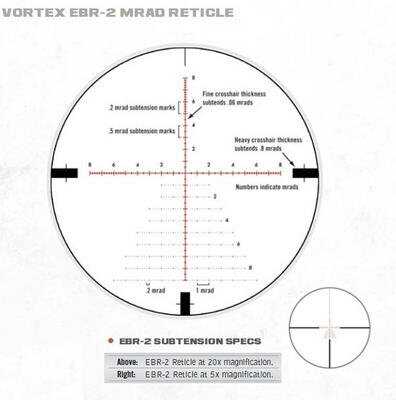
I have several of the Vortex Viper PST scopes and love them; excellent value. Things would be a whole lot easier for MRad equipped scopes if we adopted the metric system. At 100 meters a MRad is 100mm (or 10 cm) the width of the King’s fist when clenched, at 1000m the MRad subtends 1000mm (100cm or 1 meter) the distance from the King’s Crown to his crotch (if you can get the king to wear pants). Arithmetic with 10s seems a breeze compared to 3.6, .25, 1.047, .36, 21,600 etc. Try it using a MRad reticle. Well, back to the diet, I need to lose 2 Stone, a 4 Furlong run every day.
Just noticing the picture of the car at an unspecified zoom and I have to say the chromatic aberration is terrible (purple fringe). Like you said glass is everything and as a camera guy, this is not acceptable at that price point.
What ever happened to the 5mm exit pupil rule that we lived with for so long.
What ever happened to the 5mm exit pupil rule that we lived with for so long.
i JUST BROUGHT A BROWNING X BOLT IN .308 INSTALLED THE VORTEX VIPER PST 6X24X50 FFL, AND i’AM SHOOTING 1/2 MOA AT 100 YARDS. THE SCOPE AND RINGS COST ME 1100.00 DOLLARS. BUT I WOULD BUY THE H.D VORTEX IF THE COMPANY WOULD TAKE THE VIPER IN TRADE. THE VIPER IS BY FORE THE BEST SCOPE I HAVE EVER OWNED AND WOULD LIKE TO UPGRADE TO THE H.D I’AM 62 YEARS OLD AND STILL SHOOT 1/2 MOA, ONLY BECAUSE OF THE FINE SCOPE I BOUGHT. THE RIFLE WAS 799.00 THE SCOPE 1100.00. IF I PUT THE H.D ON THE RIFLE WOULD PROBABLY BE SHOOTING 1/2 MOA AT 300 YARDS. IN FACT I’AM CALLING VORTEX MONDAY AND SEE WHAT I CAN DO.BUY THE SCOPE FOLKS DONT EVEN THINK ABOUT IT, YOU’LL BE GLAD YOU DID. THANKS CLIFF
Very well written article I don’t see how all these boys have gotten butt hurt over feeling that because there favorite scope was not tested or mentioned brings up some kind of inferiority complex I agree it is an expensive optic and there are less expensive options available but for what you have described I would purchase one for one of my long range rifles that’s what I’m thinking this optic was designed for not for your average deer hunter that Kentucky windage and hit a deer once at 300 meters and now calls them self a precision long range marksman great review by the way
Everyone needs to keep in mind that $500 is only very cheap depending on the TYPE of scope. A $400 Zeiss 3-9x40mm is not a “cheap scope”. It works very well for its intended purpose. A $500 5-25x50mm scope is more than likely a cheap scope. All mounted on custom rifles in a 5min time period I’ve looked through S&B, Zeiss, Nikon and Swarovski and honestly felt the Zeiss looked brighter in low light. (shadows at dusk, also they were all between the 3-10 range) The different between them was very minimal however and all were very clear. Its when you get to longer ranges is when the marksmanship and glass clarity really comes into play.
500 $ is very very cheap. When you look through a $500 scope then “good glass” which costs lets say $2,500 you’ll immediately know which is which. My next is NightForce with zero lock of course, 12×22 or 25x 56.
You can get this down to a real simple way of buying a great rifle; WEATHERBY ACCUMARK with ZEISS SCOPE! And use Weatherby ammo.
The heck with your daddy’s squirrel gun, Remmington, converted to actually shoot decent. 🙂
I agree, not buying a Remington ever again, their customer service has gone so far downhill and besides, now that George Soros owns a big chunk of Remington they will be out of business soon anyways.
I have a scope designed by a Special Forces Sniper with Nation’s Best Sporting that I would put up against any scope in the $1500 range and I we sell if for just about half the price $800 to be exact. It will rival those in the $2,000-$3,000 range. We are in the process of getting the website up and running so we can start getting orders filled.
Its an 8-32 x 50
Fully Broadband Milti-coated lenses
Illuminated Range Finding Recitals (has both Green and Red)
Screw on Sun Shade
Smooth Power Adjustment
Superior light transmission and crystal clear viewing
1/8 MOA windage and Elevation adjustment
Water proof
3 x nitrogen purging (providing fog proofing)
Shock proof 30mm mono-tube structure
Black matted Finish.
[email protected]
This is probably a great scope. I think, however, that there is a bit of a canard about the ratio of scope to gun value in Europe. If you check out the Euro sites like gunsamerica.com, you find a huge range of gun versus scope value.
One thing different than the US is that it seems hunting is for the well-heeled in say Germany or Austria. You see very expensive guns there. I once spoke to custom gunmaker Peter Hofer and was somewhat astonished when he told me a single shot started at $85,000, a second interchangeable barrel at $8,000. This was before engraving. In France, one sees prices about one-tenth of that. But $8,000 is still a LOT of coin for a deer/pig rifle. And you routinely see European bolt rifles produced in factories (as opposed to artisanal workshops) starting at several thousand dollars.
But don’t take the word of anybody. Have a look:
Germany’s Egun.de has a page for double rifles: http://www.egun.de/market/list_items.php?mode=cat&cat=508
French site: http://www.naturabuy.fr/Express-cat-131.html
And I’ll bet that $5.00 raffle Remington 700 in 30-06 is as accurate as the German $85,000.00 custom single shot rifle. (If it is wearing a really good scope and the stock has a proper bedding.). This article was linked from an article about a precision 1/4 MOA rifle with a Rem 700 action. American rifle manufacturing has two customers, a military that is really cheap when it comes to rifles, and the American rifle shooter who demands a lot from a rifle that doesn’t cost more than your car, or some people’s homes. American manufacturers have developed sophisticated precision machining techniques that enable sub $1,000.00 rifles (or even sub $400 rifles) to fairly accurate right out of the box. It is sort of like what the Japanese did for 35mm cameras in the 1960s and 1970s. So when someone puts a $1500 scope on a $500 rifle, remember that $500 rifle could be a lot of rifle for $500.00.
A couple of years ago I bought a gun raffle ticket and won a Remington Model 700 Bolt action in 30-06 caliber. Basically the gun cost me a total of five dollars, the cost of the raffle ticket. It is a very nice rifle with a very nice wooden stock. I went out and purchased a $460.00 Nikon 2.5 to 10 variable power with a 50 MM diameter objective lens. I do not think that someone from another country will spend that much on a gun that they basically got for free. Nobody in the world has more love or respect for their guns than the american gun owner.
Call it ignorance, perhaps, but my Remington & I have never been disappointed with the results delivered by the Leupold Vari-X 3. In a variety of conditions, with ranges from 1- to 600 meters, hand-loads in 7.62×51 deliver consistent groups all day & night with little eyestrain.
I can only imagine how incredible a scope that costs three times that amount would lend my time at the range.
$500 IS cheap in the realm of Optics.
You called a $500 scope cheap? Maybe you’re being paid too much.
believe me 500 bucks for a scope is cheapIve owned them all the way to 2000.00 dollars.your paying for the glass and clickers.500 don’t get you much,you can tell it at especially at long ranges
Thanks for the article. The Razor HD is indeed an awesome scope backed by an awesome, family owned, customer service-oriented company. For 2011, Vortex redesigned the ocular shell (“eyebox”) for even more forgiving eye relief, especially at 15-20x. The illumination module has been redesigned also. This new feature is now available in the Razor HD with the new enhanced EBR-2B “Bravo” reticle, and will eventually be introduced in the EBR-1, EBR-2, and EBR-3 reticle models this spring.
One of the best optics for hard core use made in a very long time, IMO.
Scott
Why no mention of country of origin. Don’t tell me it doesn’t make a difference. If it’s from China it’s because it is cheaper to make it there. If you want the best go to Japan or Germany. Canon, Nikon and other high end camera companies make all their top line lenses in Japan or Germany. The author states that it’s the pro lenses that make the good pictures. That is completely wrong. Take a look at Ansel Adams photographs taken in the 1930’s with lenses that where made 100 years ago. That was before anti reflection coating was available. Shooters have never had access to any kind of quality reviews of the optics they use. The articles are embarrassing in there simplicity. When you can sell people binoculars that customers are told don’t require focusing or the 200 power binoculars. You know that they are selling to fools.
Scopes made by years ago by Lyman and Bausch Lomb in America are still surprisingly good. The Bausch Lomb scopes with fixed power and adjustable external mounts made a rugged combination . unfortunetly the engraved reticule was prone to collecting dust.
Scope mounting is another story. I have mounted many scopes and there is a lot of room for improvement in American scopes.
If you want to look at reviews of optics look at publications and web sites directed astronomers, bird watchers or photographers. Fred Miranda has a web site for photographers that would serve as a good example of what shooters should have access to.
Well I got that of my chest, I feel better now.
It is Japanese. I’m a Canon camera guy myself and I was happy to see that it was not some fancy looking Chinese or Russian knockoff. It is true Japanese precision.
Ansel Adams used a large format camera. Which has more resolution than you could obviously get with a small hand held 35mm or even 120 film camera. That makes a big difference in photo quality. The very reason that large format film cameras are still used today. Just thought I would mention that.
Thanks for this review – very in-depth. I will be ordering this scope for my model 700 Remington later this month.
Wait a minute………a battery??!! I won’t even look at it.
You don’t need it unless it’s dark out lol.
Never heard of ’em. Meanwhile I’ll stick to Zeiss. They’ve been at it much longer. If one feels compelled to spend more and still “Buy American”, NightForce and USOptiks are highly esteemed world-wide.
Ah, but they didn’t send us a scope to review. See how that works out yet. You have to be in the race to win it.
The Vortex Razor HD seems to good to be true,until you see how much your paying for it. Anyways The statement in the article about Americans buying a expensive gun and cheap optics,and Europeans doing the opposite to me is ass backward in my opinion. For me I would rather have the gun I want that I know is going to be worth its value in the long run. Then buying a gun that is cheaper then the gun I really want so I can have a more expensive optic. Basically what it comes down to is if you know how to shoot or you dont. You can put the best optics on the best gun out there and if you dont know what your doing you wasted your money. And for the men and women of this country that r just using Iron sights without no optics more power to you. Just my opinion from a novice shooter I found out the hard way, learn proper technigues b4 you buy.
Yes, that is why I said $1,000 rifle. We have already proven in our pages that you can install a Straightjacket on an inexpensive deer rifle and have a gun that will shoot 1/4MOA. Ben has also started a series on sniper training, and the AMU guys have done some great stuff on good shooting. When you attempt to shoot your rifle at extreme long ranges you will see that you wasted your money if you try to do it with a cheap scope. You will think it is your rifle, your own ability, but you are severely hampering yourself with a cheap scope, regardless of what you paid for the rifle.
i did and i submitted it already………………..
I’ve never noticed that it ndeeed it, but sighting it in after any kind of major disturbance or jarring movement is always a good idea. As far as shooting to clear out the oil and junk, cleaning the barrel should have done that if you actually got the barrel clean. The cleaning pads should be coming out as clean as when they went in order for the barrel to be considered clean. The same goes for the inner workings of the rifle. Unless you’re using way too much oil there shouldn’t be any heavy residue left anywhere on the gun.
Just came across your article about the Razor HD Vortex rifle scope. Good job. However its a little too rich for me at this time BUT, I’am interested in The Vortex Crossfire 8 x 32 x 50 rifle scope. I cannot find out anything out there about it on any forums. Lots at the Vortex site but, you know how that goes and you almost always get what you pay for. Lots of good info at their web site. Thats what caught my eye. Do you have anything on the Crossfire or can you direct me to some real world insite on that scope. thanks john
My observation of Vortex is that you’ll get a lot for your money, but that was why I broke out the different features in the article. I would so get a Vortex before any of the usual suspects they sell in Bass Pro. It’s just a totally different world.
In scope parallax adjustment the head is moved side to side, not back and forth.